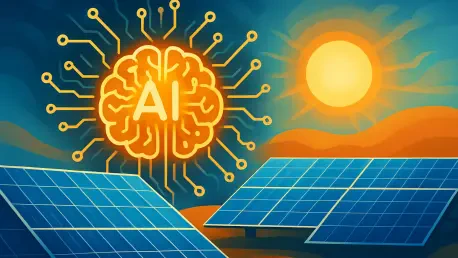In the dynamic realm of renewable energy, artificial intelligence (AI) stands as a revolutionary force, fundamentally altering the landscape for solar and storage professionals in remarkable ways. As the industry grapples with escalating demands for efficiency and scalability, AI has emerged as an indispensable tool, driving innovations that streamline every facet of solar projects—from initial design to long-term operation. This technology is not merely enhancing existing processes; it is redefining what’s possible, enabling installers, developers, and engineering firms to tackle complex challenges with unprecedented precision. Imagine cutting design timelines dramatically or anticipating customer needs before they surface—AI is making such feats a reality, fostering a smarter, more connected approach to clean energy adoption.
The significance of AI extends beyond individual tasks, addressing systemic hurdles in the solar and storage sector, such as navigating intricate regulations and integrating battery systems into diverse project scales. By automating repetitive workflows and delivering actionable insights, AI empowers professionals to focus on strategic decision-making, ultimately accelerating the shift toward sustainable energy solutions. This transformation is evident across residential, commercial, and utility-scale applications, where AI-driven software is breaking down barriers to accessibility and efficiency. As the industry continues to evolve, the role of AI in shaping a more responsive and adaptable ecosystem cannot be overstated, setting the stage for a deeper exploration of its impact.
AI as the Core of Solar Software Innovation
Automating Design and Permitting Processes
AI has become a cornerstone of solar software, transforming labor-intensive tasks like design and permitting into swift, accurate operations that save both time and resources. Advanced algorithms now detect potential obstacles, such as rooftop obstructions in commercial installations, with a level of detail that manual methods could never achieve. This automation not only minimizes human error but also allows teams to allocate their expertise to higher-value activities, such as optimizing project layouts for maximum energy yield. By handling the grunt work, AI ensures that designs are completed faster, often reducing timelines from days to mere hours, which is a critical advantage in an industry where speed can determine competitiveness.
Moreover, the impact of AI on permitting processes marks a significant leap forward for solar professionals navigating regulatory mazes. Software equipped with intelligent systems can generate compliant plan sets in minutes, automatically researching local building codes and ensuring adherence to specific jurisdictional requirements. This capability eliminates the delays that once plagued project approvals, enabling installers and developers to maintain tight schedules without sacrificing accuracy. As a result, firms can take on more projects simultaneously, confident that AI is handling the intricate details of compliance with precision, ultimately fostering greater trust from clients and authorities alike.
Enhancing Decision-Making with Predictive Insights
AI’s ability to enhance decision-making through predictive insights is reshaping how solar teams approach risk and opportunity in their projects. By analyzing vast datasets, AI tools can forecast potential issues, such as customer dissatisfaction or design flaws, long before they become costly problems. For instance, sentiment analysis algorithms assess client interactions to identify signs of frustration, allowing companies to intervene proactively and maintain positive relationships. This forward-thinking approach is invaluable in maintaining project momentum and ensuring client retention in a competitive market.
Equally transformative is AI’s role in refining project models with sophisticated analytics, particularly for large-scale utility initiatives where the stakes are elevated. By simulating various scenarios and quantifying uncertainties, AI provides developers with a clearer picture of potential outcomes, enabling more informed choices about resource allocation and timelines. This predictive power helps mitigate risks associated with complex installations, ensuring that budgets and schedules remain on track. As AI continues to evolve, its capacity to deliver real-time, data-driven insights is becoming a vital asset for firms aiming to stay ahead in an increasingly intricate energy landscape.
Seamless Integrations Powered by AI
Building Connected Workflows
The integration of AI into solar software is fostering a connected ecosystem where disparate systems communicate effortlessly, significantly enhancing workflow efficiency. Modern platforms now link seamlessly with a variety of tools, including project management applications and utility data services, to create a unified process from initial lead generation to final installation. AI plays a pivotal role in ensuring compatibility across these systems, intelligently mapping data flows to eliminate redundancies and reduce manual input. This interconnectedness means that updates in one area, such as design adjustments, are instantly reflected across sales and financing modules, minimizing errors and accelerating project timelines.
Furthermore, the impact of AI-driven integrations extends to operational scalability, allowing solar firms to handle larger volumes of work without compromising quality. By automating data transfers between platforms, AI ensures that critical information is always accessible to the right stakeholders at the right time, whether it’s a sales team closing a deal or an engineering group finalizing plans. This streamlined approach not only saves time but also enhances collaboration across departments, breaking down silos that once hindered progress. As a result, companies can respond more swiftly to market demands, positioning themselves as agile players in a fast-paced industry focused on renewable energy growth.
Streamlining Financing and Customer Engagement
AI is also revolutionizing the way solar software integrates with financing systems, making the process of securing funding faster and more accessible for homeowners and businesses alike. By leveraging real-time data analysis, AI connects design platforms with financing providers to deliver instant quotes and approval timelines that were once unimaginable. This rapid turnaround is crucial for maintaining customer interest, as delays in funding can often derail potential projects. Additionally, AI ensures that these integrations prioritize user-friendliness, presenting complex financial information in clear, digestible formats that empower clients to make informed decisions with confidence.
Beyond financing, AI enhances customer engagement by personalizing interactions through integrated platforms, ensuring that homeowners feel valued throughout their solar journey. Tools powered by AI can generate tailored savings projections and energy usage reports, directly addressing client concerns about costs and benefits. These features foster transparency, a key factor in building trust, especially for residential customers new to solar technology. By bridging the gap between technical software and customer-facing solutions, AI creates a cohesive experience that not only simplifies the adoption process but also encourages positive word-of-mouth, driving further growth in the sector as more individuals see the tangible benefits of clean energy.
Customization Through AI for Diverse Needs
Adapting to Regional and Project-Specific Demands
AI’s capacity to customize solar software solutions to meet regional and project-specific demands is proving to be a game-changer in an industry characterized by diverse requirements. Algorithms can now adapt designs to account for local environmental factors, such as shading patterns or weather conditions, ensuring that each installation maximizes energy output. Moreover, AI tools automatically adjust to jurisdictional regulations by pulling relevant building codes and standards, eliminating the need for manual research and reducing the risk of non-compliance. This tailored approach is essential for projects spanning different geographies, where a one-size-fits-all solution simply cannot address the nuanced challenges of varied landscapes and regulatory frameworks.
In addition, AI-driven customization supports a wide range of project scales, from small residential setups to sprawling commercial arrays, without requiring teams to start from scratch for each new endeavor. Software platforms equipped with intelligent features allow users to set default preferences based on past projects or regional norms, streamlining the design process and maintaining consistency across installations. This adaptability saves significant time and resources, enabling firms to take on diverse workloads while still delivering high-quality, personalized outcomes. As solar adoption grows globally, AI’s role in catering to specific needs ensures that technology remains a versatile ally for professionals navigating an ever-expanding market.
Supporting Long-Term Energy Planning
AI is also instrumental in supporting long-term energy planning, particularly for distributed energy resources and hybrid solar systems that require forward-looking strategies. By modeling scenarios that span decades into the future, AI tools account for variables like rate structure changes, policy shifts, and technological advancements, providing developers with robust frameworks for decision-making. This capability is critical for utility-scale projects where investments must yield returns over extended periods, ensuring that plans remain viable even as external conditions evolve. Such foresight helps mitigate financial risks and aligns projects with broader sustainability goals.
Furthermore, the precision of AI in long-term planning extends to optimizing resource allocation and grid integration for complex energy setups. Algorithms analyze historical data alongside predictive trends to recommend the most efficient configurations for solar and storage combinations, balancing immediate needs with future demands. This strategic planning is especially vital as hybrid systems become more prevalent, requiring seamless coordination between generation and storage to meet grid reliability standards. By enabling developers to anticipate challenges and opportunities well in advance, AI ensures that renewable energy projects are not just reactive but proactively designed for enduring success in a dynamic energy landscape.
AI’s Role in Storage and Hybrid Systems
Addressing Battery Energy Storage Challenges
As battery energy storage systems (BESS) become integral to solar installations, AI is stepping in to address the unique challenges associated with these hybrid setups. Advanced tools now offer real-time pricing analytics, helping developers evaluate the cost-effectiveness of storage solutions under varying market conditions. This data-driven approach ensures that investments in BESS are grounded in accurate financial projections, reducing uncertainty and enhancing project viability. AI also optimizes battery sizing and placement within solar arrays, ensuring that storage components complement energy generation for maximum efficiency, a critical factor in meeting both residential and commercial energy demands.
Additionally, AI tackles the operational complexities of battery systems by monitoring performance metrics and predicting maintenance needs before issues arise. By analyzing usage patterns and environmental factors, these intelligent systems can extend the lifespan of storage units, minimizing downtime and replacement costs. This proactive management is especially important in hybrid systems where solar and storage must work in tandem to provide consistent power, particularly during peak demand or grid outages. As the shift toward integrated renewable solutions accelerates, AI’s ability to streamline BESS implementation is proving indispensable for developers aiming to deliver reliable, cost-effective energy options to a growing market.
Optimizing Performance and Grid Integration
AI’s contribution to optimizing the performance of hybrid solar-plus-storage systems is equally significant, particularly in how it manages interactions with the electrical grid. Sophisticated algorithms simulate power flows to identify potential bottlenecks in interconnection, ensuring that systems deliver energy efficiently without overloading infrastructure. This analytical capability is vital for large-scale projects where grid stability is a top priority, allowing developers to design setups that align with utility requirements while maximizing output. By fine-tuning these interactions, AI helps maintain a balance between local energy needs and broader grid demands, supporting overall system reliability.
Moreover, AI enhances grid integration by forecasting energy production and consumption trends, enabling better coordination between solar generation, battery storage, and grid supply. This predictive modeling ensures that excess energy is stored effectively during low-demand periods and released during peaks, reducing strain on the grid and lowering costs for end-users. Such precision is crucial as hybrid systems gain prominence, requiring seamless synchronization to meet modern energy challenges like fluctuating demand and renewable intermittency. Through these intelligent optimizations, AI is paving the way for a more resilient energy network, where solar and storage can play a central role in stabilizing and sustaining power delivery across diverse applications.
Prioritizing Customer Experience with AI
Proactive Communication and Support
AI is redefining customer service within the solar industry by enabling proactive communication that addresses client concerns before they escalate into larger issues. Through sentiment analysis, AI tools evaluate interactions to detect early signs of dissatisfaction, allowing companies to intervene with targeted solutions promptly. This foresight prevents project delays and cancellations, maintaining a smooth workflow while fostering stronger client relationships. Virtual assistants, powered by AI, further enhance this support by providing round-the-clock responses to project-specific inquiries, ensuring that customers always have access to timely information regardless of time zones or business hours.
Additionally, the integration of AI into customer support systems streamlines issue resolution by categorizing and prioritizing inquiries based on urgency and complexity. This intelligent triaging ensures that critical concerns are escalated to human representatives quickly, while routine questions are handled automatically, saving time for both clients and staff. Such efficiency not only improves satisfaction but also builds trust, as customers perceive the company as responsive and attentive to their needs. In an industry where word-of-mouth referrals can significantly impact growth, AI’s role in enhancing communication is a powerful driver of business success, ensuring that every interaction leaves a positive impression.
Transparency in Savings and Financing
AI is also playing a pivotal role in boosting transparency around savings and financing, key factors in encouraging solar adoption among homeowners and small businesses. By leveraging real-time data, AI-driven tools generate instant savings projections tailored to a customer’s specific energy usage and location, demystifying the financial benefits of going solar. This clarity helps clients understand the long-term value of their investment, addressing a common barrier to entry where uncertainty about returns can deter potential adopters. Such transparency transforms complex calculations into accessible insights, empowering customers to make decisions with confidence.
Equally important is AI’s impact on simplifying the financing process, ensuring that funding options are presented clearly and processed swiftly through integrated platforms. By connecting directly with lenders, AI systems provide pre-approval estimates and ethical funding alternatives, reducing the time and stress associated with securing loans. This streamlined approach not only enhances the customer experience but also increases conversion rates, as clients are more likely to commit when financial hurdles are minimized. As solar continues to expand into new markets, AI’s ability to make savings and financing transparent is crucial for building trust and driving widespread acceptance of renewable energy solutions among diverse consumer bases.
Reflecting on AI’s Lasting Impact
Looking back, the integration of AI into solar and storage software marked a turning point for the renewable energy sector, delivering efficiencies that redefined industry standards. Automation of design and permitting tasks drastically reduced timelines, while predictive analytics empowered professionals to navigate risks with greater certainty. Seamless system integrations bridged gaps between sales, financing, and installation, creating cohesive workflows that saved resources and enhanced scalability. Customization, driven by intelligent algorithms, ensured that solutions met the unique demands of each project, from local regulations to long-term planning.
Reflecting on these advancements, it’s clear that AI also elevated customer experience to new heights, fostering trust through proactive support and transparent financial insights. Its role in optimizing hybrid systems addressed critical challenges in battery storage and grid integration, supporting the rise of resilient energy networks. Moving forward, the focus should be on expanding access to these AI tools, ensuring smaller firms and emerging markets can leverage their benefits. Continued collaboration among software developers, industry stakeholders, and policymakers will be essential to refine these technologies, addressing evolving needs and sustaining the momentum toward a cleaner, more sustainable energy future.









